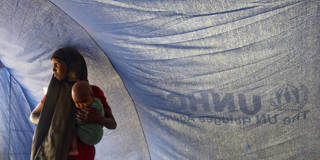A decade after 150 governments adopted the "Responsibility to Protect," the world's record in defending populations from mass-atrocity crimes remains grim. But the prevailing explanation for this failure – a conflict between “the West,” promoting intervention, and “the rest,” defending sovereignty – is misleading.
BERLIN – Ten years ago, world leaders agreed that the international community had a “responsibility to protect” populations from genocide, crimes against humanity, war crimes, and ethnic cleansing. A decade later, the world’s record in fulfilling the Responsibility to Protect (R2P) remains poor, with hundreds of thousands of people in Iraq, Syria, Myanmar, Sudan, South Sudan, the Central African Republic, Burundi, Nigeria, and the Democratic Republic of the Congo still threatened by mass atrocities. If R2P is to work for them, we must dispel some widespread myths and focus our energies on the practical challenges of protection.
As it stands, many pundits see little promise for R2P, foreseeing instead an intensifying deadlock between Western interventionists and non-Western stalwarts of sovereignty. Many find only reason for despair in the global rise of powers like China and India, whose elites were socialized in opposition to the Western-led order from which R2P emerged. Those countries’ resistance to intervention, says Harvard’s Michael Ignatieff, “will become increasingly influential.”
But is sovereignty really what emerging powers are defending? And does effective protection of populations always come down to intervention?

BERLIN – Ten years ago, world leaders agreed that the international community had a “responsibility to protect” populations from genocide, crimes against humanity, war crimes, and ethnic cleansing. A decade later, the world’s record in fulfilling the Responsibility to Protect (R2P) remains poor, with hundreds of thousands of people in Iraq, Syria, Myanmar, Sudan, South Sudan, the Central African Republic, Burundi, Nigeria, and the Democratic Republic of the Congo still threatened by mass atrocities. If R2P is to work for them, we must dispel some widespread myths and focus our energies on the practical challenges of protection.
As it stands, many pundits see little promise for R2P, foreseeing instead an intensifying deadlock between Western interventionists and non-Western stalwarts of sovereignty. Many find only reason for despair in the global rise of powers like China and India, whose elites were socialized in opposition to the Western-led order from which R2P emerged. Those countries’ resistance to intervention, says Harvard’s Michael Ignatieff, “will become increasingly influential.”
But is sovereignty really what emerging powers are defending? And does effective protection of populations always come down to intervention?